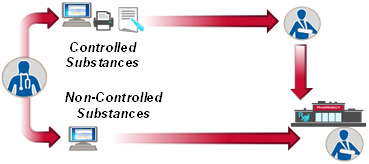HIMSS14 Takeaways: Hospitals Eyeing Electronic Prescribing of Controlled Substances
At HIMSS14, we had a number of in-depth conversations with IT leaders at hospitals and health systems from across the U.S. about their challenges, strategies and priorities for 2014 and beyond. One particular issue that is top-of-mind for many of the folks we talked to is electronic prescribing of controlled substances (EPCS).

As we’ve discussed in previous blog posts, we are seeing increased interest from customers in EPCS, but there remains a number of questions about the regulatory and technology requirements. There are also several steps in the process that get overlooked. At HIMSS, we were able to garner some terrific insight into how healthcare organizations are thinking about EPCS. Some of the key takeaways include:
- The U.S. Drug Enforcement Agency (DEA) regulations with respect to EPCS are complex. Healthcare IT leadership is cautiously navigating the DEA requirements, and is relying on technology providers to help them understand the regulations.
- There is a desire to eliminate the manual workflow of writing prescriptions for controlled substances. Many organizations have been e-Prescribing non-controlled substances for years, which improves prescribing accuracy, provider efficiency and patient safety. Relying on manual processes for prescribing controlled substances has an inverse effect, leading to decreased productivity and potential patient satisfaction and safety issues.
- Hospitals are looking to help meet Meaningful Use goals by adopting EPCS. Meaningful Use Stage 1 requires that 40 percent of all prescriptions are electronic. Stage 2 raises the threshold to 65 percent and introduces an optional requirement for hospitals — a 10 percent threshold of e-Prescribing at patient discharge. Many organizations we spoke with think EPCS can help them meet these targets.
- Organizations want a solution which supports all the strong authentication modalities allowed by the DEA. While fingerprint biometrics is by far the most preferred method of signing an electronic prescription, IT wants flexibility to use the right mix of authentication modalities that best fits their clinical workflow requirements.
These are just a few of the EPCS-related topics and issues that we discussed during HIMSS14. It is clear that interest in EPCS remains high, but questions about the requirements and strategies for moving forward with an EPCS project remain.
Are you considering EPCS? If so, we’d love to hear your thoughts, questions and/or concerns.
